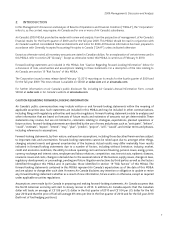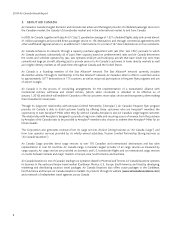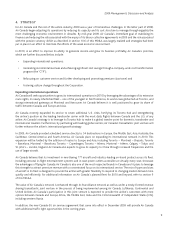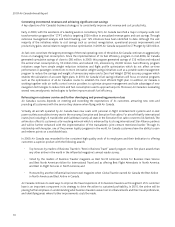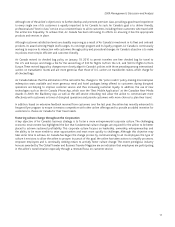Air Canada 2009 Annual Report Download - page 17
Download and view the complete annual report
Please find page 17 of the 2009 Air Canada annual report below. You can navigate through the pages in the report by either clicking on the pages listed below, or by using the keyword search tool below to find specific information within the annual report.2009 Management’s Discussion and Analysis
17
• A RASM decline of 7.3% from the fourth quarter of 2008, which was mainly due to the lower yield but also to the
decrease in passenger load factor.
U.S. transborder passenger revenues decreased 3.7% from the fourth quarter of 2008
U.S. transborder passenger revenues of $405 million in the fourth quarter of 2009 decreased $16 million or 3.7% from the
fourth quarter of 2008 due to lower traffi c as yield grew 1.4% year-over-year. In the fourth quarter of 2009, U.S. transborder
capacity was reduced by 1.8% from the fourth quarter of 2008. Components of the year-over-year change in fourth quarter
U.S. transborder passenger revenues included:
• A traffi c decline of 5.0% on a capacity reduction of 1.8%, which resulted in a passenger load factor decline of
2.5 percentage points from the fourth quarter of 2008.
• Air Canada’s Toronto – Austin and Vancouver – Sacramento routes were suspended in the second half of 2009
while these routes operated in the fourth quarter of 2008. Partly offsetting these capacity decreases was increased
capacity to Florida, in order to capitalize on more stable leisure demand, and the introduction of services from
Calgary to Portland, as well as services from Calgary to Honolulu and Calgary to Maui and to San Diego.
• A yield increase of 1.4% from the fourth quarter of 2008, which refl ected yield improvements on all major U.S.
transborder services with the exception of U.S. sun routes and routes from western Canada to western U.S. where
additional capacity and aggressive competitive pricing adversely impacted yields. Yield in the economy cabin was
unchanged from the same period in 2008 while yield in the premium cabin increased 2.7% year-over-year.
• A RASM decrease of 1.9% from the fourth quarter of 2008, which was due to the passenger load factor decrease.
Atlantic passenger revenues decreased 4.8% from the fourth quarter of 2008
Atlantic passenger revenues of $376 million in the fourth quarter of 2009 decreased $18 million or 4.8% from the fourth
quarter of 2008 due to a lower yield as traffi c increased 2.4% year-over-year. In the fourth quarter of 2009, Atlantic
capacity was increased by 6.7% from the fourth quarter of 2008. Capacity was increased on all major Atlantic services with
the exception of Spain and Tel Aviv where capacity was reduced year-over-year. Components of the year-over-year change
in fourth quarter Atlantic passenger revenues included:
• A traffi c increase of 2.4% on the capacity growth of 6.7%, which resulted in a passenger load factor decrease of
3.3 percentage points from the fourth quarter of 2008.
• The capacity growth in the fourth quarter of 2009 refl ected new routes, such as Montreal – Geneva and additional
frequencies on Calgary – Frankfurt, which was also partly offset by a suspension earlier in the year of the
Toronto – Madrid service for the winter and a reduction in frequencies to Tel Aviv.
• A yield decline of 7.0% from the fourth quarter of 2008, which refl ected the continued weak economic environment,
increased fare discounting to stimulate traffi c and reduced fuel surcharges year-over-year. Additional traffi c growth
in the fourth quarter was accepted at lower yields in an attempt to fi ll the capacity growth which resulted in
additional pressure placed on yields. Yield declines were refl ected on all major Atlantic services with the exception of
Spain where yield improved year-over-year.
• A RASM decrease of 10.8% from the fourth quarter of 2008, which was due to both the lower yield and the
passenger load factor decrease.
Pacifi c passenger revenues decreased 9.7% from the fourth quarter of 2008
Pacifi c passenger revenues of $199 million in the fourth quarter of 2009 decreased $21 million or 9.7% from the fourth
quarter of 2008 due to a lower yield as traffi c grew 4.2% year-over-year. In the fourth quarter of 2009, capacity was
increased by 6.5% from the fourth quarter of 2008 with growth refl ected on all major Pacifi c services with the exception
of Korea where capacity was reduced year-over-year. Components of the year-over-year change in fourth quarter Pacifi c
passenger revenues included:
• A traffi c increase of 4.2% on the capacity increase of 6.5%, which resulted in passenger load factor decline of
1.8 percentage points from the fourth quarter of 2008. Air Canada increased its capacity in the fourth quarter on the


